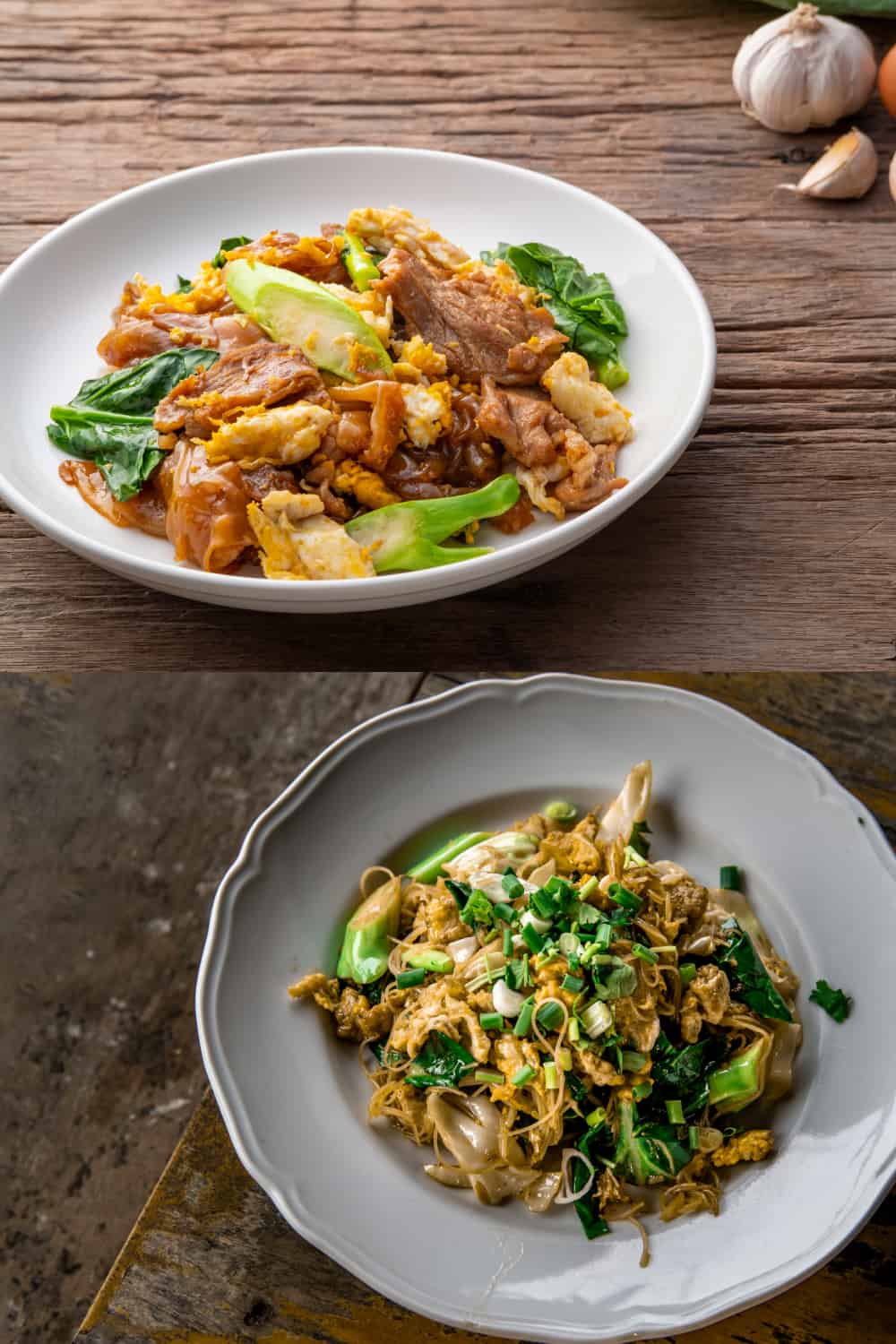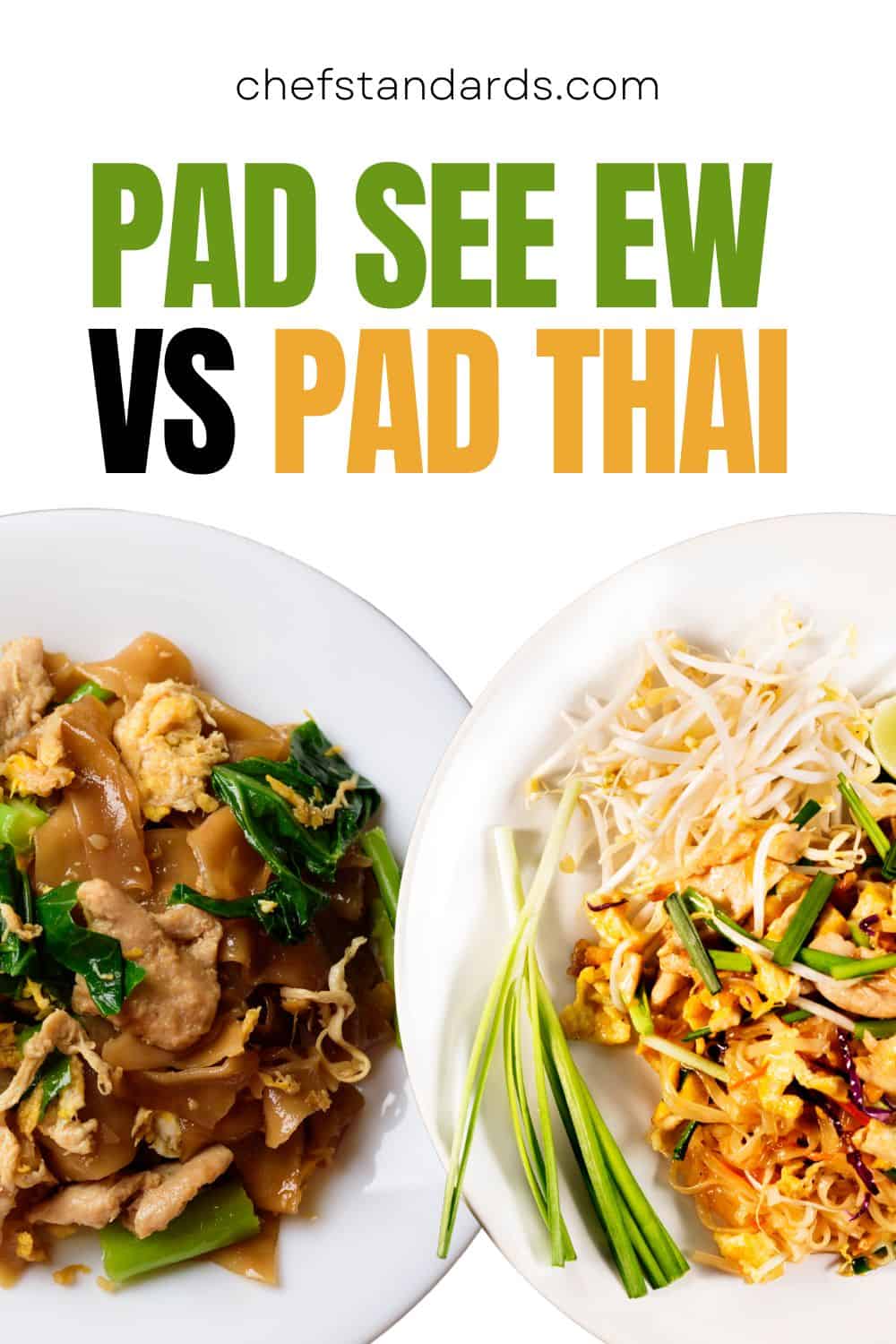Although not the first choice for all people, Thai cuisine is gaining popularity very fast and spreading the cultural dash of Eastern cuisine to the West.
The main stars of this Asian cuisine are lots of veggies, herbs, sauces, some proteins, and of course, the main ingredient, noodles.
If your mouth waters when reading this and you are looking to satisfy your Thai noodle cravings, you must try two popular Thai dishes known as Pad See Ew and Pad Thai.
Since you will probably find them at restaurants under the same description: stir-fried noodles with vegetables and your choice of protein, many people think that they are the same.
Although similar, there are some major differences between Pad See Ew and Pad Thai, and the two main differences are the noodles and the sauce used when making them.

What Are The Origins Of The Two Classic Noodle Dishes?
The Main Difference: While Pad See Ew has a long history dating back to Chinese immigrants who brought it to Thailand, Pad Thai is a relatively new dish that was created in the 1930s as part of a government-sponsored campaign.
Although these two types of dishes both have their roots in Thailand, they have slightly different histories.
Pad See Ew, which translates to “stir-fried soy sauce noodles”, has quite a long history and it is believed that it originated in central Thailand, particularly in the City of Bangkok.
However, its real origins can be traced back to Chinese immigrants who came to Thailand and brought with them a stir-fried noodle dish made with soy sauce, vegetables, and meat or seafood.
Pad Thai, on the other hand, is a relatively new dish, which is believed to have been created in the 1930s as part of a government-sponsored campaign to promote national identity and encourage the consumption of rice noodles.
It was created by a Chinese Thai chef named Thawatchai Phanphurek, who sought to create a dish that was uniquely Thai.
Popularity Contest Between Pad See Ew And Pad Thai

The Main Difference: Both types of dishes are very popular in Thailand, but Pad Thai is a much more well-known dish around the world, probably because it has been promoted as a national dish of Thailand in many Thai restaurants around the world.
While both types of dishes are highly regarded and popular in Thailand, Pad Thai is a well-known Thai dish all around the world, especially in the United States where it can be found in many Thai restaurants.
I assume that many of you are wondering why it is so considering that these two are very similar types of dishes.
Well, it is believed that it is due to the fact that Pad Thai has been promoted as a national dish of Thailand, and has been featured in many Thai restaurants around the world.
Pad See Ew, on the other hand, is a less-known dish outside of Thailand but is still a very popular and beloved dish within its home country, where it is a common street food and is served in many restaurants, especially in Bangkok.
How Do They Differ Based On The Type Of Noodles?

The Main Difference: Pad See Ew uses flat rice noodles that are wider and thicker, while Pad Thais’s main ingredient is rice sticks, a thinner variation of rice noodles.
When it comes to the ingredients, I will start with the one ingredient which these types of dishes are best known for, namely noodles. Noodles are the main ingredient of so many popular dishes including Tan Tan noodles, Hakata ramen, Udon dish, etc.
Both Pad See Ew and Pad Thai both use rice noodles (one of the most popular gluten-free Chinese food) as their main ingredient.
However, in traditional Pad See Ew, flat rice noodles, also known as “sen yai” in Thai, are used. These noodles are thicker and wider than the rice noodles used in Pad Thai. They have a quite chewy texture and absorb sauces well.
Namely, Pad See Ew has a heavier sauce and thicker noodles that are a perfect match to capture the flavor of that same sauce.
Pad Thai, on the other hand, uses thinner rice noodles also known as rice sticks (called “sen lek” in Thai). They have a delicate and light texture that complements the other ingredients in the dish quite well.
They work well with Pad Thai because they already have an immense amount of toppings and seasonings.
These rice noodles also cook much faster than wider rice noodles, which is important in stir-fried dishes where ingredients are cooked rapidly over high heat.
See Also: 9 Main Differences Between Egg Noodles Vs Rice Noodles
What Is The Difference Between Sauces In Pad See Ew And Pad Thai?

The Main Difference: While Pad See Ew uses soy sauce as its main ingredient, sauce that is the combination of tamarind paste, fish sauce, lime juice, and sugar is the key player in Pad Thai.
Both of these Thai dishes contain some kind of sauce that gives them their unique flavor profile. However, because of their different ingredients, as well as the slightly different cooking process, the type of sauce is also different.
When it comes to Pad See Ew, it is all about soy sauce, i.e. it is the base sauce of this dish. This sauce combines sweet and savory flavors, but savory flavors are much more pronounced.
Also, it is added to the stir-fried noodles towards the end of the cooking process to ensure that the noodles are evenly coated.
Aside from soy sauce, black soy sauce and oyster sauce are sometimes used as well.
Pad Thai is a different story because its main sauce is made from different ingredients.
The main ingredient in the sauce is tamarind paste and the paste is typically combined with fish sauce, lime juice, and sugar.
Unlike soy sauce, this tamarind sauce is cooked down with noodles and other ingredients, allowing it to thicken and coat the noodles the right way.
What Are The Differences Between Other Ingredients?

The Main Difference: While the topping of Pad See Ew relies on just a few ingredients, Pad Thai usually incorporates various different ingredients that give it its unique flavor profile and texture.
Besides noodles and sauces, there are some other ingredients that give the full flavor profile to these dishes.
Those ingredients are mainly related to the topping of the dish which gives it some extra flavor and texture.
Namely, Pad See Ew usually doesn’t have too many ingredients when it comes to topping and it focuses on simplicity. In most cases, fried eggs, sliced meat (chicken in most cases, or fish and shrimp), and Chinese broccoli are added.
Some other types of ingredients may include chopped green onions (add fresh, oniony flavor), crushed peanuts (add a crunchy texture and nutty flavor), and lime wedges (tangy, citrusy twist to the dish).
Pad Thai is a different story since it relies on the philosophy “the more, the better”. It is also the case with Pad See Ew, crushed peanuts are usually added.
However, there are some other ingredients as well, including bean sprouts (adding a bit of sweetness to the dish), cilantro (providing your dish with a bright green color and fresh flavor), and tofu (a protein-rich topping with a mild flavor).
Pad See Ew Vs Pad Thai: Overall Flavor Profile

The Main Difference: While both types of dishes have somewhat savory and sweet flavors, Pad See Ew has a darker and deeper flavor with the addition of smoky undertones.
Since both types of dishes contain ingredients with a lot of flavors and textures, they both have quite complex flavor profiles.
However, they do not contain the same range of foods, which means they have distinct flavor profiles.
To begin with, Pad See Ew is a savory dish with a slight sweetness. Soy sauce and oyster sauce can provide it with characteristic umami flavors, and the addition of garlic adds a fresh, slightly bitter note.
Pad See Ew has a darker and deeper flavor than Pad Thai with the addition of smokey undertones, and the texture is chewier since Pad See Ew noodles are wider than those used in Pad Thai.
On the other hand, the flavor of Pad Thai is not that deep and dark, but it is also a combination of sweet and savory flavors to some extent.
It also has pops of sour and tickles of acid that make for an exciting flavor journey.
What Is Healthier, Pad See Ew Or Pad Thai?
The Main Difference: Pad See Ew is considered slightly healthier than Pad Thai since it contains fewer calories as well as a lower sodium content.
Although they are both nutritious and full of proteins and carbs, there are some slight differences between the two. In order to understand the main differences, take a look at the table below which shows the main information about their nutritional value.
Nutritional Profiles of Pad See Ew and Pad Thai (per 1 cup):

As you can see from this table, both types of dishes have a decent amount of protein, carbs, and fiber and they are relatively low in fat. (1) (2)
However, Pad See Ew is lower in calories and that gives it a slight advantage. Aside from that, although both are relatively high in sodium, Pad See Ew has a slightly lower sodium content.
And since you all know that high amounts of sodium are not good for your health, it is easy to conclude that Pad See Ew beats Pad Thai here as well.
What Are The Main Similarities Between Pad See Ew And Pad Thai?
Since they are quite similar types of dishes, Pad See Ew and Pad Thai must have some similarities as well. And yes, both types of dishes are stir-fried noodles that go through almost the same cooking process.
Namely, if you want to cook any of them, you will need a wok to stir-fry them. And the techniques used for producing these dishes are nearly identical.
The only difference is in the ingredients used to make them and in the fact that the sauce in Pad See Ew is added towards the end of the cooking process.
Also, the wok you will use to make one of these two dishes is the same. However, it is important to choose the right one. Carbon-steel variety is the best, but an aluminum or stainless woks will also work for both dishes.
The right wok also depends on the stove being used. If you are cooking on an electric stovetop, it is best to use a flat-bottomed wok. On the other hand, regular round-bottomed woks are mostly suitable for gas stoves.
When cooking these dishes in the wok, both types require oil which has a high smoking point. Some of those oils include refined canola oil, refined grapeseed oil, refined peanut oil, as well as sunflower oil.
Butter or olive oil is not recommended for these types of dishes.
Finally, the cooking time is also very similar, i.e. the cooking times for each are short, usually under 10 minutes.
If you want to know how to make one of the most popular Thai noodle dishes, here is the video.
Sources:
1. Healthline (2022), Pad Thai Calories, accessed 6 March 2023
2. Nutritionix (2016), Pad See Ew- 1 Cup, accessed 6 March 2023

